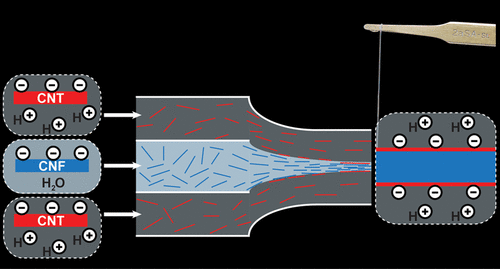当前位置:
X-MOL 学术
›
ACS Appl. Nano Mater.
›
论文详情
Our official English website, www.x-mol.net, welcomes your
feedback! (Note: you will need to create a separate account there.)
Coaxial Spinning of Oriented Nanocellulose Filaments and Core–Shell Structures for Interactive Materials and Fiber-Reinforced Composites
ACS Applied Nano Materials ( IF 5.3 ) Pub Date : 2020-09-17 , DOI: 10.1021/acsanm.0c02192 Andrew Marais 1 , Johan Erlandsson 1 , L. Daniel Söderberg 2 , Lars Wågberg 1, 2
ACS Applied Nano Materials ( IF 5.3 ) Pub Date : 2020-09-17 , DOI: 10.1021/acsanm.0c02192 Andrew Marais 1 , Johan Erlandsson 1 , L. Daniel Söderberg 2 , Lars Wågberg 1, 2
Affiliation

|
Spinning filaments from nature’s own high-performance building block, cellulose nanofibrils (CNFs), requires additional considerations compared to conventional manmade fibers commonly made from polymer solutions or melts. We herein utilize the colloidal properties of the highly anisotropic CNFs and demonstrate the preparation of core–shell filaments using a coaxial nozzle. The nanofibril dispersion is passed through the core channel, and the sheath flow consists of a functionalizing solution. The flow rates of the suspensions/solutions are carefully controlled to create an extensional flow at the exit of the nozzle, allowing orientation of the nanofibers into continuous filaments that are then extruded into a fixation bath before drying. The self-assembly mechanism relies on the control of the colloidal stability of carboxymethylated CNFs altered by pH or ionic strength changes. In the simplest approach, HCl is used in the sheath flow to assemble the accelerated CNFs in the core flow, leading to an irreversible association of the nanofibers into an oriented filament. The filaments are continuous and homogeneous, with a dry diameter of approximately 20 μm. The orientation of the CNFs in the spun filament was investigated by wide-angle X-ray scattering, and an orientation index of 0.79 is achieved. The tensile strength of the filaments is 431 ± 89 MPa, the Young’s modulus is 19.2 ± 3.4 GPa, and the strain at break is 7.4 ± 1.3%. Core–shell structures are also prepared by incorporating active materials such as carbon nanotubes in the sheath flow. The resulting filaments show a thin shell of a conductive nanotube network covering a core of cellulose nanofibrils, and the conductivity of such structures reaches 1000 S cm–1, opening up opportunities for composites and interactive materials.
中文翻译:

取向纳米纤维素长丝和核壳结构的同轴纺丝,用于交互式材料和纤维增强复合材料
与通常由聚合物溶液或熔体制成的常规人造纤维相比,从大自然自身的高性能构建体纤维素纳米原纤维(CNF)纺制长丝还需要考虑其他因素。我们在本文中利用了高度各向异性的CNF的胶体特性,并演示了使用同轴喷嘴制备核-壳细丝的方法。纳米原纤维分散体通过核心通道,而鞘流由功能化溶液组成。仔细控制悬浮液/溶液的流速,以在喷嘴出口处产生延伸流,从而使纳米纤维定向为连续的长丝,然后将其挤出到固定浴中,然后进行干燥。自组装机制依赖于控制因pH或离子强度变化而改变的羧甲基化CNF的胶体稳定性。在最简单的方法中,将HCl用于鞘流中以将加速的CNF组装在芯流中,从而导致纳米纤维不可逆地缔合成定向长丝。长丝是连续且均匀的,干直径约为20μm。通过广角X射线散射研究了纺丝中CNF的取向,并且获得了0.79的取向指数。长丝的抗拉强度为431±89 MPa,杨氏模量为19.2±3.4 GPa,断裂应变为7.4±1.3%。还可以通过在鞘流中掺入活性材料(例如碳纳米管)来制备核-壳结构。–1,为复合材料和互动材料开辟机会。
更新日期:2020-10-25
中文翻译:

取向纳米纤维素长丝和核壳结构的同轴纺丝,用于交互式材料和纤维增强复合材料
与通常由聚合物溶液或熔体制成的常规人造纤维相比,从大自然自身的高性能构建体纤维素纳米原纤维(CNF)纺制长丝还需要考虑其他因素。我们在本文中利用了高度各向异性的CNF的胶体特性,并演示了使用同轴喷嘴制备核-壳细丝的方法。纳米原纤维分散体通过核心通道,而鞘流由功能化溶液组成。仔细控制悬浮液/溶液的流速,以在喷嘴出口处产生延伸流,从而使纳米纤维定向为连续的长丝,然后将其挤出到固定浴中,然后进行干燥。自组装机制依赖于控制因pH或离子强度变化而改变的羧甲基化CNF的胶体稳定性。在最简单的方法中,将HCl用于鞘流中以将加速的CNF组装在芯流中,从而导致纳米纤维不可逆地缔合成定向长丝。长丝是连续且均匀的,干直径约为20μm。通过广角X射线散射研究了纺丝中CNF的取向,并且获得了0.79的取向指数。长丝的抗拉强度为431±89 MPa,杨氏模量为19.2±3.4 GPa,断裂应变为7.4±1.3%。还可以通过在鞘流中掺入活性材料(例如碳纳米管)来制备核-壳结构。–1,为复合材料和互动材料开辟机会。











































 京公网安备 11010802027423号
京公网安备 11010802027423号